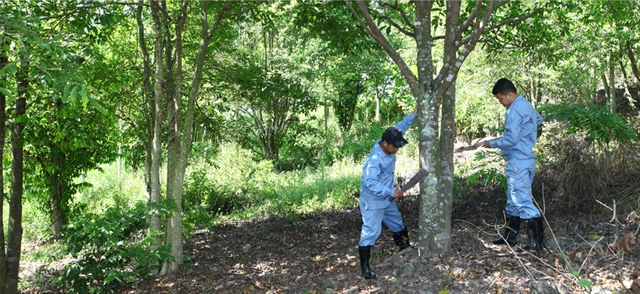 Sunday/Weekend
Sunday/Weekend

 |
| Hoàng Trầm Agarwood Culture Conservation nurtures a forest of Aquilaria trees that produce the “Wood of the Gods" in Khánh Hòa Province. Photos courtesy of Hoàng Trầm |
Thanh Hà
In addition to its white sandy beaches and crystal-clear turquoise waters, the central coastal city of Nha Trang is also world-renowned as the home of the finest agarwood – the "Wood of the Gods".
This precious treasure is carefully nurtured by artisan Phạm Tuấn Anh in his unique agarwood forest and conservation area, while countless fascinating stories await visitors at the Hoàng Trầm Agarwood Museum.
Inspired by his father, Tuấn Anh has cherished a deep love for agarwood since childhood. He left a career in finance and banking to spend nearly three decades pursuing his dream of bringing this precious wood closer to people while promoting Việt Nam’s agarwood to the world.
The product can only be produced from Aquilaria trees, which are native to the rainforests of Southeast Asia and some other regions.
Legacy rooted in nature
In Việt Nam, agarwood can be found in the central region from Nghệ An Province to as far as Phú Quốc Island. Among localities, Khánh Hòa's agarwood reserves and quality are considered among the best in the world with manufacturers from Taiwan Island, Japan, the Middle East and Europe using Khánh Hòa's agarwood for their most expensive and high-end products.
 |
| Farm workers take care of Aquilaria trees in the conservation area. |
"A healthy Aquilaria tree becomes wounded and is infected by certain moulds or fungi. As a defence mechanism, the tree produces a dark, aromatic resin to protect itself from the infection," said Anh.
"Over time, this resinous secretion accumulates in the heartwood, transforming the pale, odourless wood into the dark, fragrant agarwood. The more resin the tree secretes, the darker and more valuable the wood becomes."
The value of agarwood is written in Vietnamese scholar Lê Quý Đôn's book Miscellaneous Chronicles of the Pacified Frontier in the late 18th century.
He noted that agarwood was "the fragrance of the heaven carried by the wind, setting on the wounded part of the Aquilaria tree and nurtured by soil, sun, and sea breeze, and other natural conditions -- making it truly the spiritual essence of heaven and earth".
Anh began his work in 2000 planting more than 30,000 trees over an area of 30ha in Diên Thọ Commune, about 20km from Nha Trang in Khánh Hòa Province. After five years of many challenges, he successfully covered the entire land with Aquilaria.
 |
| Many valuable agarwood blocks and artefacts are exhibited in the Hoàng Trầm Museum. |
"I thought I had both the ability and passion to create a sustainable, green, quality agarwood brand that wins the trust of Vietnamese and international customers," said Anh.
He now owns a forest, a conservation area, and a museum dedicated to Khánh Hòa’s agarwood – which he believes to be the most fragrant in the world, produced by Aquilaria trees that thrive in the region’s arid soil and harsh climate.
The dark, aromatic and resinous wood is highly prized for its distinctive scent. It is used in perfumes due to its rich, woody and earthy fragrance; incense for religious ceremonies and creating a calming atmosphere; and in traditional medicine for therapeutic properties, believed to treat ailments like nausea, asthma, and digestive issues.
"Agarwood is the most magical product in the world. Major religions in the world such as Buddhism, Christianity, Islam, and Hinduism have employed agarwood in their worship," said Tuấn Anh.
 |
| Phạm Tuấn Anh (centre) introduces his agarwood products and specimens to visitors. VNS Photo Hải Lăng |
"The ancient belief is that the captivating scent of agarwood serves as a bridge connecting humans to the spiritual realm, conveying their wishes to the gods. It is the only scent that cannot be created in the laboratory -- no one has yet fully deciphered the chemical structure of agarwood molecules," he added.
Preserving sacred heritage
The conservation area was established with an aim to preserve the Aquilaria trees and develop sustainable agarwood forest as natural sources became over-exploited.
It is the only "agarwood tourism" model in Việt Nam open to visitors, offering unique experiences such as forest tours, visits to seed nurseries, and workshops for crafting agarwood products.
In 2015, he built an exhibition space so that Vietnamese people and international visitors could learn about agarwood in the best way.
 |
| Phạm Tuấn Anh and his agarwood products which were on display at the Exhibition of 80 Years of National Achievements in August in Hà Nội. VNS Photo Ngọc Phạm |
At the Hoàng Trầm Agarwood Museum, visitors explore 3,000 years of agarwood history through ancient documents and a diverse collection of agarwood specimens and artefacts.
"We have a collection of really valuable artefacts -- including large blocks of agarwood weighing 5kg, 10kg and even 20kg, some up to 70 years old," he said.
"There are also Buddha statues carved from over 100-year-old agarwood blocks. They are incredibly valuable and hold great historical and cultural significance."
Many other pieces help distinguish Khánh Hòa agarwood from that of other regions.
"Here, we organise programmes to attract tourists passionate about agarwood. I'm pleased to see a growing number of visitors interested in learning about and using agarwood products," Anh said.
 |
| Artisan Phạm Tuấn Anh in his agarwood forest. |
"Previously, people only knew agarwood burners and bracelets, but now there are many other practical products -- such as agarwood tea and wine," Anh added.
A demonstration of extracting agarwood is one of the most captivating activities for visitors. The process requires patience and precision to remove unused parts and gradually reveal the aromatic heartwood.
At the museum, visitors are introduced to the art of agarwood appreciation, experiencing its fragrances in an artistically rich and meditative setting.
 |
| Visitors are introduced to the art of agarwood appreciation in the museum. |
According to experts, agarwood when burnt, can emit fragrance in eight waves over 24 hours. Each wave unfolds a distinct scent profile -- sometimes vanilla, pine or musk.
Even more fascinating, the same agarwood can release slightly different aromas in different places at the same time.
Those who appreciate the fragrance must reach a state of calm and focus to discern and name each scent. Through this process, Anh said, they can purify their thoughts and find tranquillity and peace amid the noise and chaos of modern life. VNS




